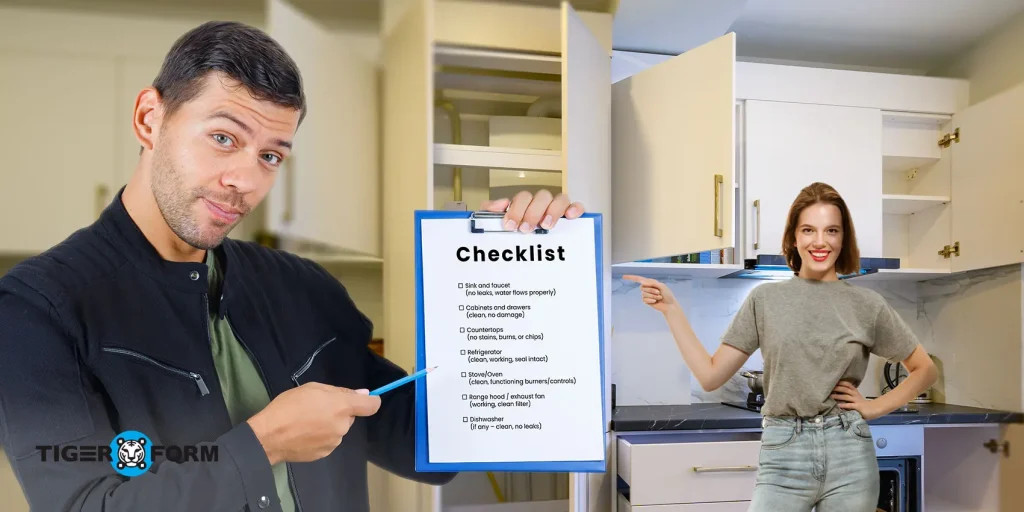
Rental property inspection forms help document the property’s condition at different stages of the rental cycle, providing clarity and legal protection for landlords, property managers, and tenants.
According to a survey by Buildium, in 2025, maintenance was identified as the second‑greatest challenge for property management companies. They reduce the risk of conflict, streamline maintenance tracking, and create a reliable record for security deposit decisions or legal claims.
In this blog, we’ll explore the different types of rental inspection forms, how to use them effectively, what should be included in each, and how to start building your own with a form builder.
What is a rental inspection checklist?
A rental inspection checklist is a detailed document used by landlords and tenants to assess a rental property’s condition before and after move-out. It typically includes all rooms, fixtures, appliances, and exterior areas, allowing both parties to note the current state of the property.
These checklists are especially valuable because they promote inspection consistency, reduce human error, and provide documented proof of the property’s condition.
They also help identify maintenance issues early before they become costly repairs, and are essential for security deposit disputes.
This checklist is important because it protects both the tenant and the landlord. For tenants, it ensures they aren’t held responsible for pre-existing damages. For landlords, it provides proof of the property’s condition at different stages, which is useful when determining if repairs or deductions from the security deposit are needed.
Overall, it promotes transparency, prevents disputes, and helps maintain the property’s condition over time.
Below are some sample checklists per section:
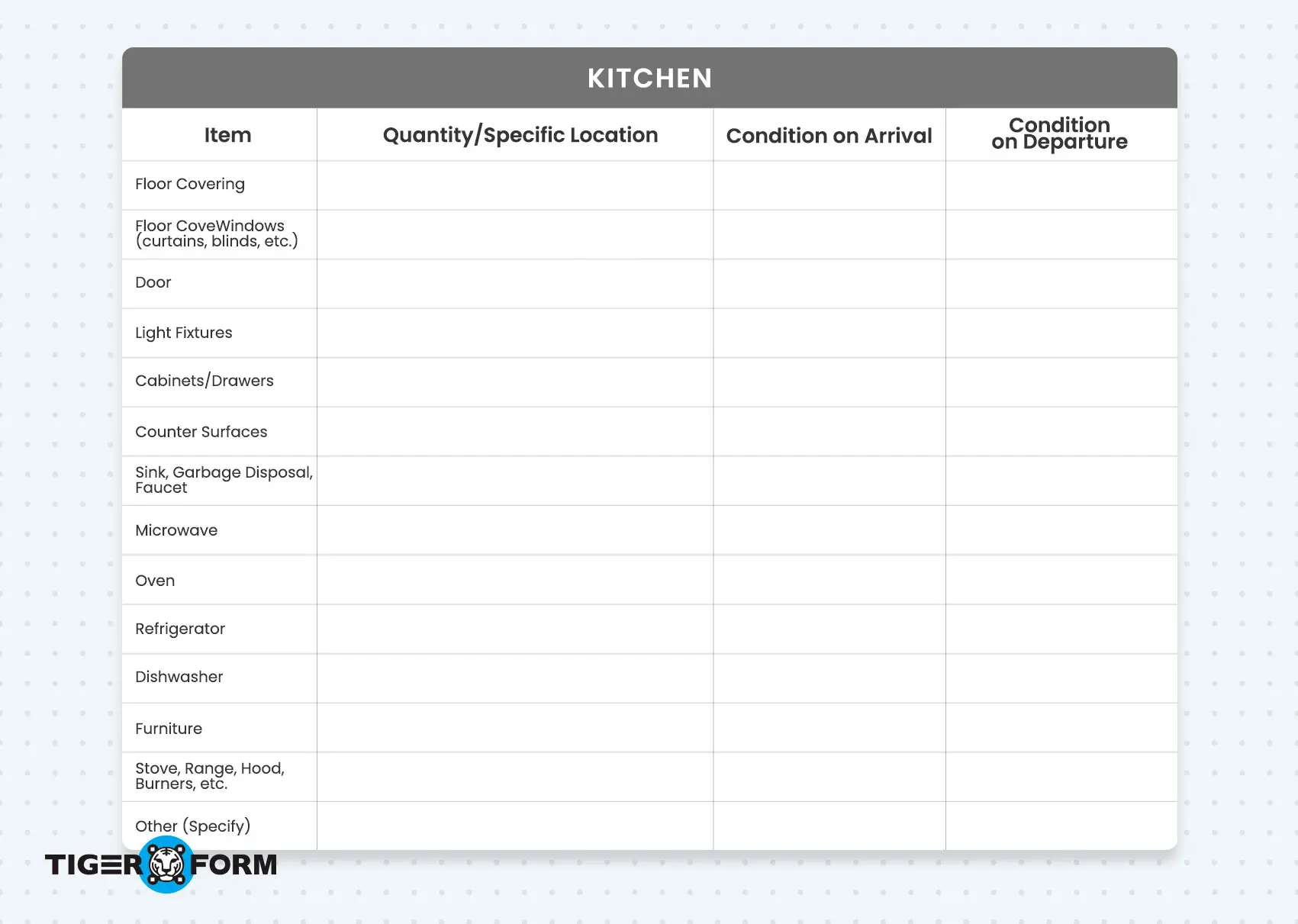
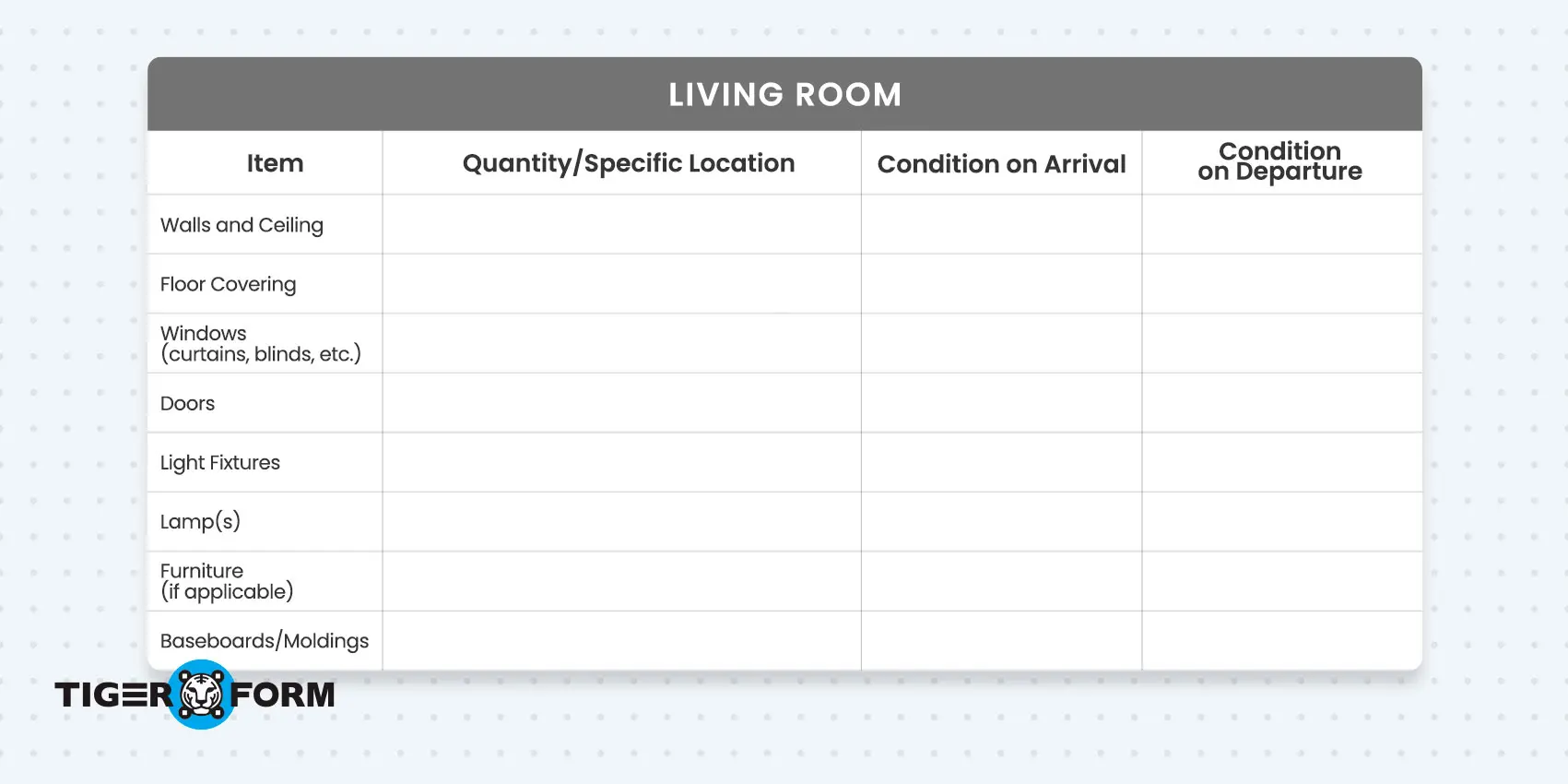
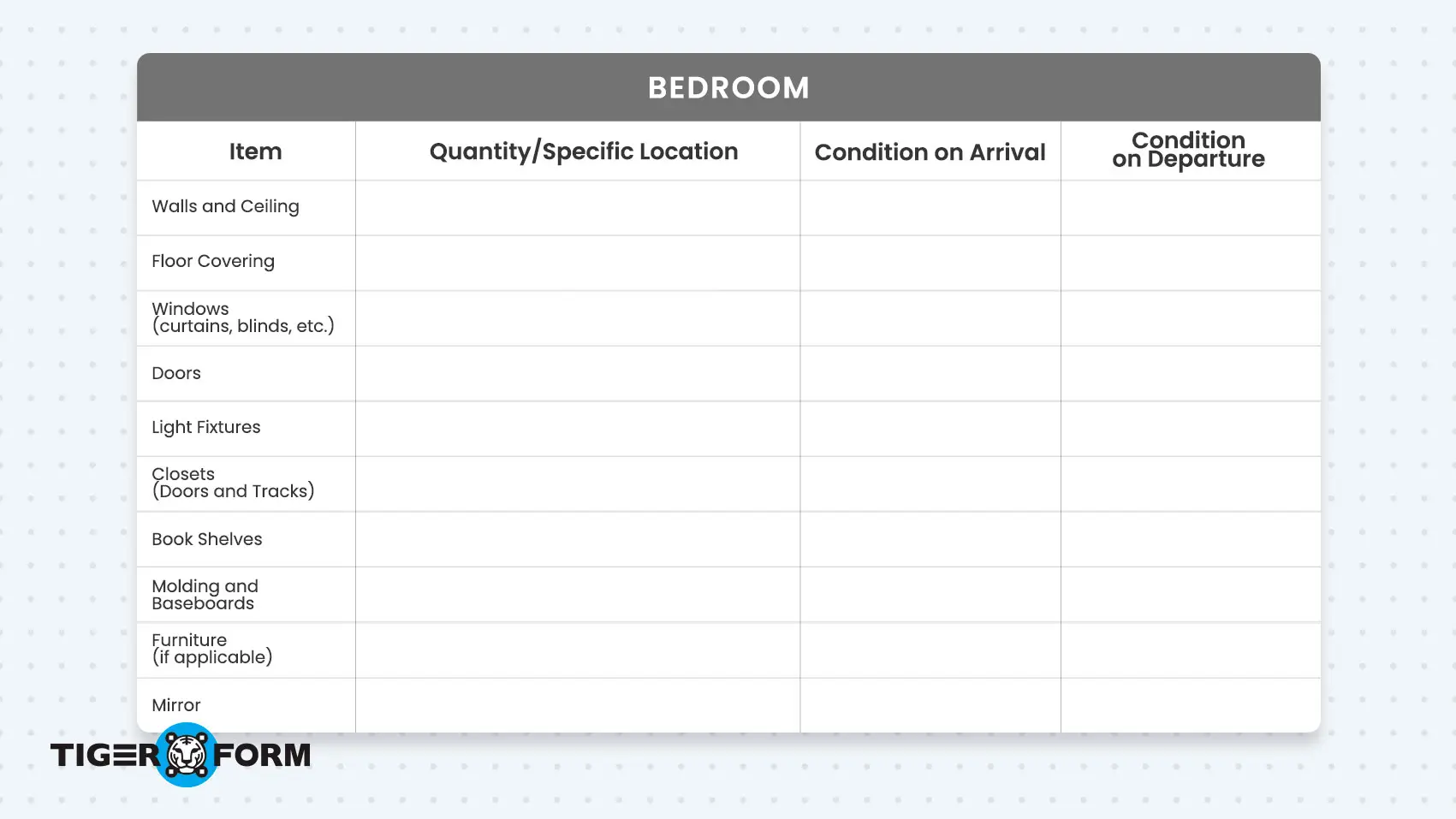
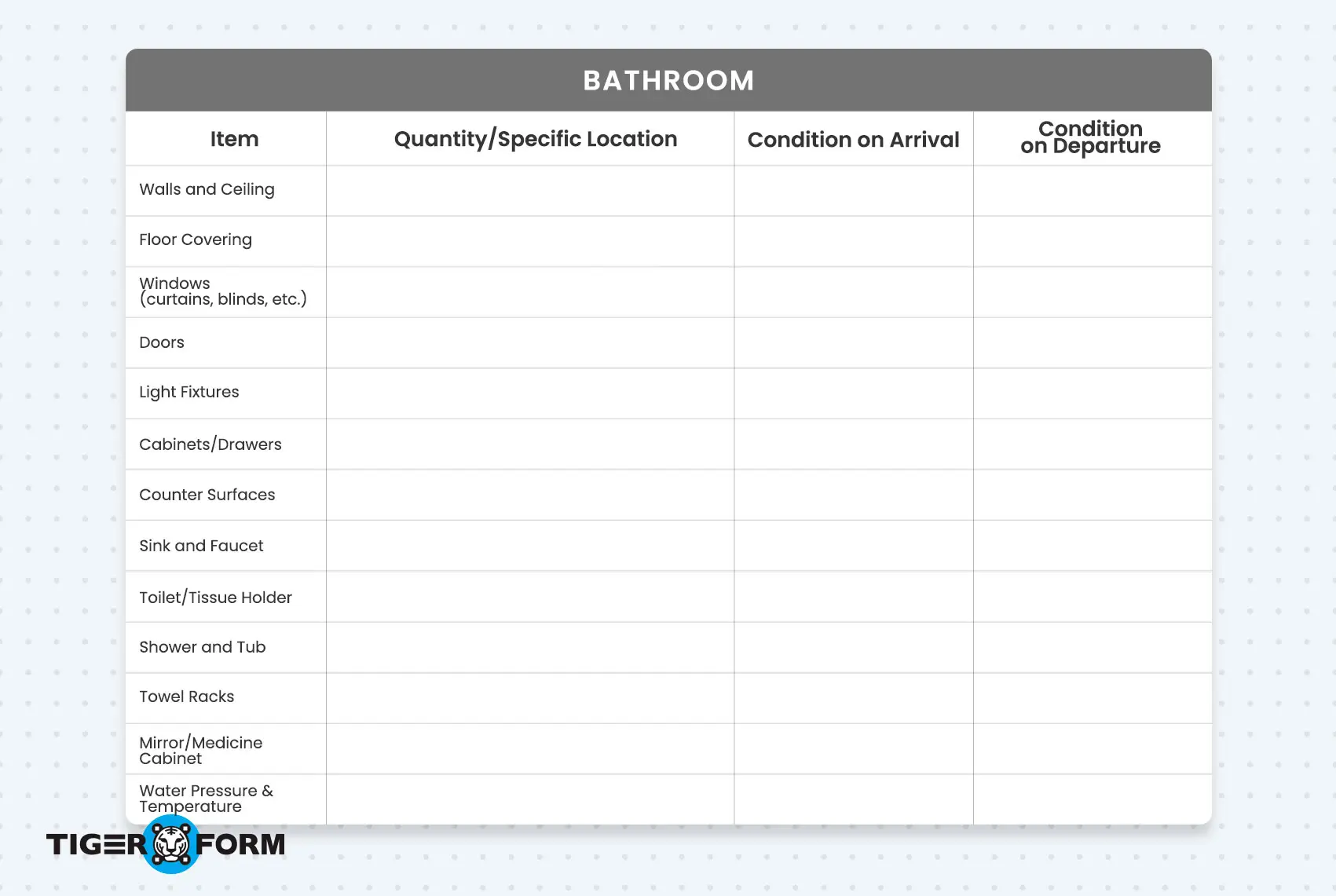
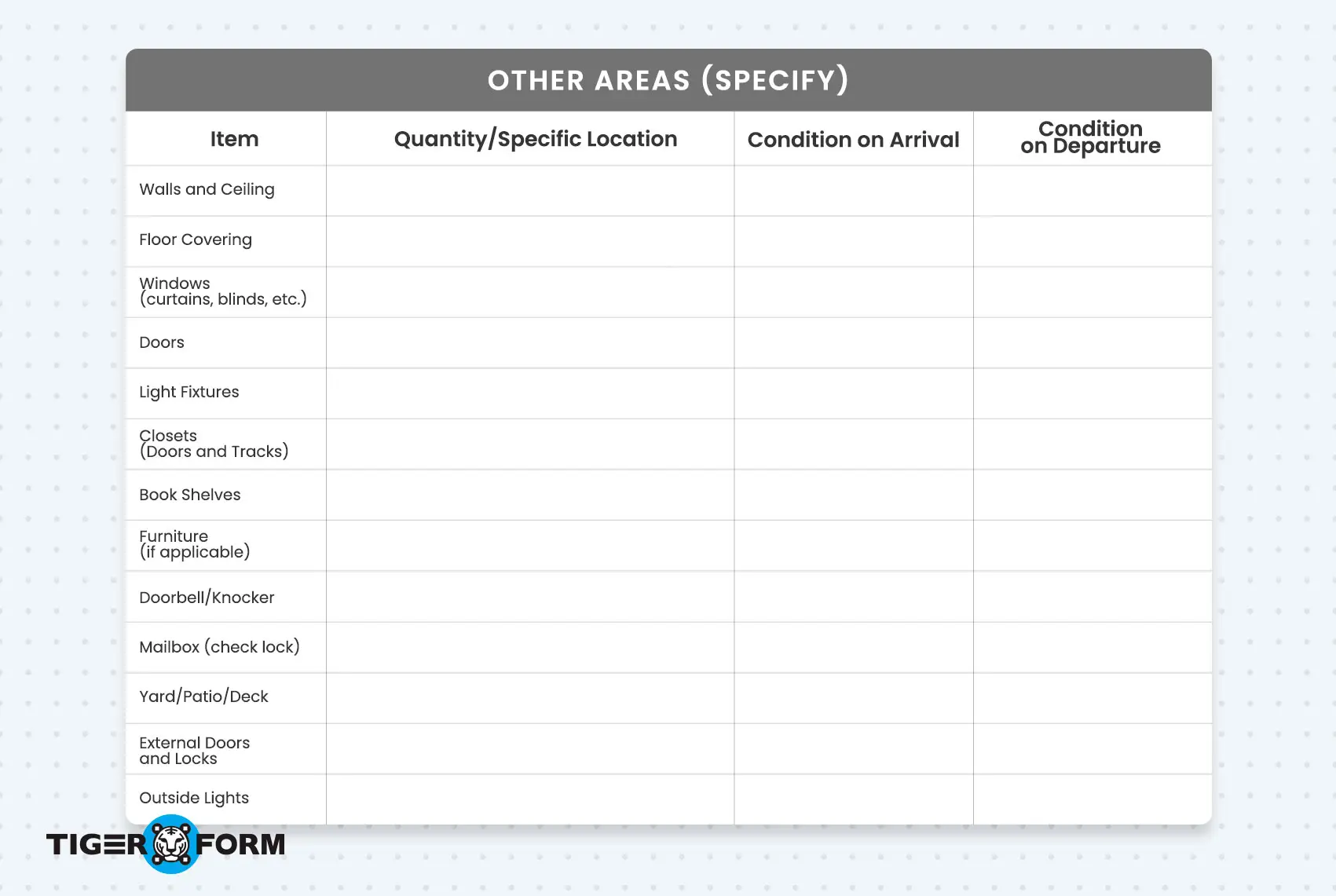
Why are rental inspection checklists and forms important?
A rental property inspection form is a standardized document used to record the condition of a rental property before a tenant moves in and after they move out. It includes detailed sections for each room and major items in the property like walls, floors, doors, windows, appliances, and fixtures. This form acts as one of the most reliable data collection methods in rental management, allowing landlords and tenants to document the property’s condition with accuracy from the start and end of a lease.
Legal Protection: A signed inspection form acts as legal evidence in disputes. Courts often rely on these records when handling disagreements over security deposit deductions.
39.0% of Tenancy Tribunal applications involved bond (deposit) refunds, meaning nearly 4 out of 10 tribunal cases centered on recovering security deposits
Tenant Accountability: When tenants see that the property’s condition has been documented, they are more likely to maintain it properly. It builds a sense of shared responsibility.
Dispute Prevention: The form helps avoid misunderstandings by mutually agreeing on the property’s initial condition. This reduces conflicts at the end of the lease.
Maintenance Tracking: Repeated use of inspection forms creates a property maintenance history. This helps landlords identify patterns, plan repairs, and reduce emergency costs.
13 types of rental property inspection forms
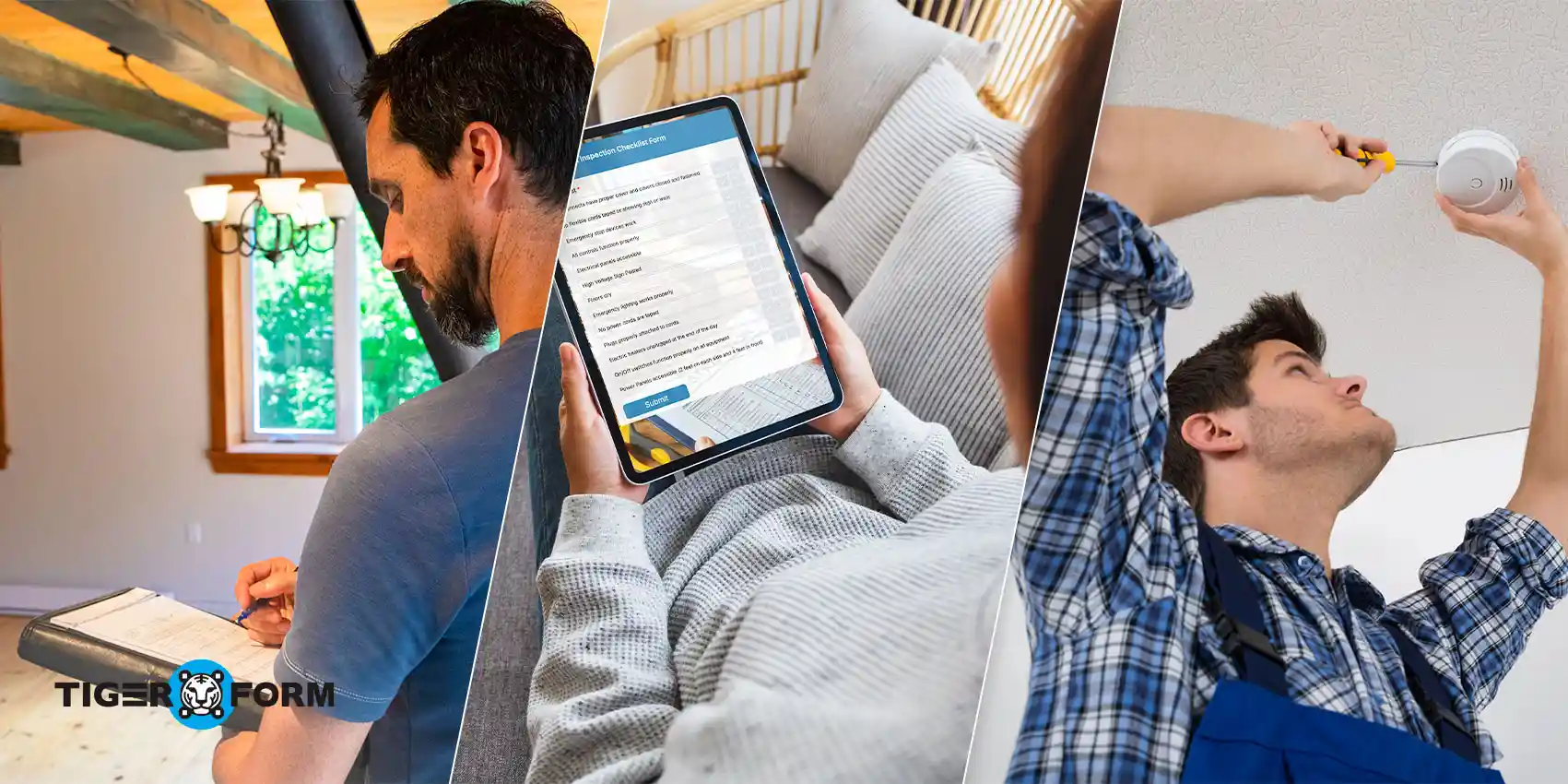
Move-in inspection form
A move-in inspection form is a document used to record the exact condition of a rental property when a new tenant takes possession. It acts as a formal agreement between the landlord and the tenant, outlining the state of every room, surface, appliance, fixture, and amenity at the start of the lease.
The primary goal of this form is to create a clear, written record of the property’s condition to prevent future disagreements, especially around the return of the security deposit. According to Zillow’s Consumer Housing Trends Report 2022, 73% of recent renters plan to move again within the next three years.
If any damage is found at the end of the tenancy, the move-in form helps distinguish between pre-existing issues and tenant-caused damage. Without it, landlords may have difficulty making legitimate claims, and tenants may face unfair deductions.
What it includes:
- Date of inspection and lease start date
- Names and signatures of the landlord and the tenant
- Room-by-room checklist (walls, floors, doors, windows, lights, appliances, plumbing, etc.)
- Space for notes or remarks on damage or wear
- Option to attach photos for visual documentation
- Statement of agreement confirming that the parties accept the documented condition
Move-out inspection form
A move-out inspection form is a document used at the end of a tenant’s lease to assess the condition of the rental property before it is vacated. It is compared side-by-side with the move-in inspection form to determine if any damage occurred during the tenancy.
The move-out form helps landlords decide if deductions from the tenant’s security deposit are necessary, based on wear and tear versus tenant-caused damage. It also allows tenants to dispute unfair charges with a documented reference.
This form is essential for ensuring a fair and transparent move-out process. It reduces the risk of disputes and helps both parties clearly understand any required repairs or cleaning charges.
What it includes:
- Inspection date and lease end date
- Tenant and landlord/property manager names and signatures
- Checklist for all rooms and features (floors, walls, appliances, lights, plumbing, etc.)
- Comparison notes (e.g., “same as move-in,” “damaged,” “needs repair”)
- Photo evidence (optional but highly recommended)
- Notes on missing items, cleanliness, or unreported damage
- Final comments and signature section to confirm inspection results
Routine inspection form
A routine inspection form is used by landlords or property managers to periodically check the condition of a rental property while a tenant is still living there. These inspections are usually scheduled every 3 to 6 months, depending on local laws and lease agreements.
The main purpose of a routine inspection is to ensure that the property is being properly maintained, that tenants are complying with the lease terms, and to spot any issues like leaks, damage, or safety hazards before they become costly.
Routine inspections protect the property’s long-term value and help catch problems early. They also give tenants the chance to raise concerns they may not have reported otherwise.
What it includes:
- Date of inspection and next scheduled check
- Tenant and inspector (landlord/property manager) details
- Checklist covering:
- Cleanliness of property
- Condition of fixtures, flooring, and walls
- Functionality of appliances
- Signs of water damage, pest infestations, or mold
- Outdoor areas like gardens, balconies, or shared spaces
- Notes on tenant-reported issues or repairs needed
- Space for photographs and observations
- Signature section for both tenant and inspector (optional but recommended)
Rental property self-inspection form
A rental property self-inspection form is a checklist provided to tenants so they can conduct a basic inspection of the rental property themselves. This form became especially popular during the COVID-19 pandemic when in-person inspections were limited, and continues to be used when access is restricted or for remote property management. It allows tenants to report the current condition of the property, flag maintenance concerns, and ensure that all items are in good working order all without a landlord physically being present.
This form encourages tenant responsibility, improves communication, and helps landlords maintain their properties even when remote or managing multiple units. It’s especially useful in long-term tenancies where landlords want periodic updates.
What it includes:
- Tenant name, property address, and date of inspection
- Checklist for all rooms and utilities (walls, plumbing, electrical, HVAC, smoke detectors, etc.)
- Yes/No fields for “working properly” and space to describe any issues
- Option to upload or attach photos of any damage or areas of concern
- Tenant signature to confirm honest reporting
Property management inspection checklist
A property management inspection checklist is a comprehensive form used by professional property managers to perform scheduled or routine inspections across one or more units. It is more detailed than typical landlord forms and includes both physical and administrative checks.
It ensures that properties meet habitability, legal, and lease agreement standards, and helps property managers maintain consistency and documentation across an entire rental portfolio. For professional property managers, this checklist provides a systematic, documented approach to managing multiple units. It minimizes liability, tracks repair trends, and supports better budgeting and tenant retention.
What it includes:
- Property address, inspector name, and inspection type (move-in, move-out, routine, etc.)
- Checklist for:
- Structural integrity (roof, windows, walls)
- Mechanical systems (plumbing, electrical, HVAC)
- Safety features (smoke detectors, fire extinguishers, locks)
- Grounds and common areas (driveways, gardens, hallways)
- Cleanliness and tenant compliance (e.g., unauthorized pets or guests)
- Notes on required repairs, vendor work orders, or follow-up actions
- Digital photos and timestamped entries (if using software tools)
- Final sign-off by the property manager or inspection team
Landlord inspection form
A landlord inspection form is a simplified checklist used by individual landlords, especially those managing one or a few properties to personally assess the condition of their rental unit. It can be used during move-in, move-out, or regular walk-throughs.
It helps landlords document property conditions and ensure tenants are complying with lease terms, even without the involvement of a professional property manager. It ensures a simple, structured process for independent landlords, helping them avoid disputes and maintain property standards without extra costs or third-party involvement.
What it includes:
- Date of inspection and reason (move-in, routine, etc.)
- Sections for each room and major area (kitchen, bathroom, living room, exterior)
- Notes on cleanliness, damage, and repairs needed
- Space for tenant and landlord comments
- Signatures for agreement and transparency
Rental inspection report form
A rental inspection report form is a finalized version of one or more inspections (e.g., move-in and move-out) compiled into a single summary document. It is often used for record-keeping, property evaluations, or legal purposes.
This serves as an official report showing how a property has changed over time, what maintenance has been performed, and whether tenant behavior contributed to damage or repairs. This report creates a complete historical record of a rental property’s condition, useful for legal disputes, deposit claims, or even selling the property in the future
What it includes:
- Basic property and tenant information
- Summary of inspection findings from each visit
- Comparative notes (e.g., damage that occurred during tenancy)
- Photos or attachments as visual evidence
- Action items or deductions (if applicable)
- Signatures from tenant and landlord or property manager
Tenant repair request form
A tenant repair request form allows tenants to formally report maintenance issues or request repairs to the landlord or property manager. It ensures all requests are documented and tracked efficiently. And helps to create a clear line of communication between tenants and landlords and ensure repairs are handled in a timely and traceable manner.
It encourages responsible reporting, speeds up response time, and protects both parties by keeping a written record of all repair-related communication. Most local laws require landlords to provide this form within a set number of days (often 15–30) after a tenant moves out. A detailed, well-documented form reduces legal risks and shows that deductions are fair and evidence-based.
What it includes:
- Tenant name and property address
- Description of the issue (e.g., “leaky faucet in kitchen”)
- Priority level (urgent, routine, emergency)
- Optional photo upload
- Date of request and preferred access time
- Landlord or manager response section (for status and notes)
Security deposit itemized deduction form
A security deposit itemized deduction form is a legal document given to a tenant after they move out, detailing any amounts withheld from their deposit and why.
This helps to comply with landlord-tenant laws that require transparency and documentation when deducting from a security deposit.
What it includes:
- Original deposit amount
- List of deductions (e.g., “Wall repair – ₹1,200,” “Carpet cleaning – ₹800”)
- Reason for each deduction and any supporting details
- Final balance to be refunded to the tenant
- Date of issue and contact information for follow-up
Property release form
A property release form is a document completed at the end of a tenancy to confirm that the tenant has fully vacated the property and returned all keys, access devices, or related items. It acts as a formal “handover” agreement between the landlord and the tenant.
It protects landlords from claims of unlawful lockout and gives tenants proof that they’ve officially handed the property back, which can be important for deposit disputes or legal matters.
What it includes:
- Property address and tenant’s name
- Date of move-out and key return
- Confirmation that tenant has removed personal items
- Notes on final inspection or pending issues
- Signatures from both parties
Environmental health property inspection
An environmental health property inspection is usually conducted by a local authority or certified inspector to ensure the property meets basic health and safety standards, especially in rental housing or low-income housing programs.
Failure to meet environmental health standards can result in fines, legal action, or being banned from renting out the property. It’s especially important in areas with rental licensing or inspection mandates.
What it includes:
- Checks for mold, dampness, pest infestations, and structural hazards
- Sanitation systems (toilets, plumbing, garbage disposal)
- Ventilation and air quality
- Water safety and hygiene
- Electrical and fire safety checks
- Notes on compliance with local housing codes
Survey and valuation property inspection
This form is used by professional surveyors or appraisers to assess a property’s structural condition and market value, often during sales, refinancing, or insurance underwriting. This form provides a technical and financial assessment of the property’s current state and estimates its market value.
Banks, mortgage companies, and insurers often require this inspection. It supports financial decisions and ensures buyers or investors understand the true condition of the property.
What it includes:
- Detailed notes on the structure (roof, walls, foundation, etc.)
- Measurements of property and land
- Evaluation of materials and age of the building
- Identification of any major defects or repair needs
- Market comparison for valuation
- Final estimate of property value
Insurance property inspection form
An insurance property inspection form is used by insurance companies to assess the property’s risk profile before issuing or renewing a policy. It may also be used to evaluate claims after damage occurs. Insurance providers use this form to protect themselves and the property owner from underinsuring or overinsuring. A poor inspection may lead to denied claims or higher premiums.
What it includes:
- Building structure and material checks
- Safety system evaluations (alarms, extinguishers, locks)
- Photos of key risk areas (roof, foundation, heating systems)
- Past damages, repairs, or maintenance history
- Hazard zone indicators (flood, earthquake, fire-prone areas)
What should be included in every rental property inspection form?
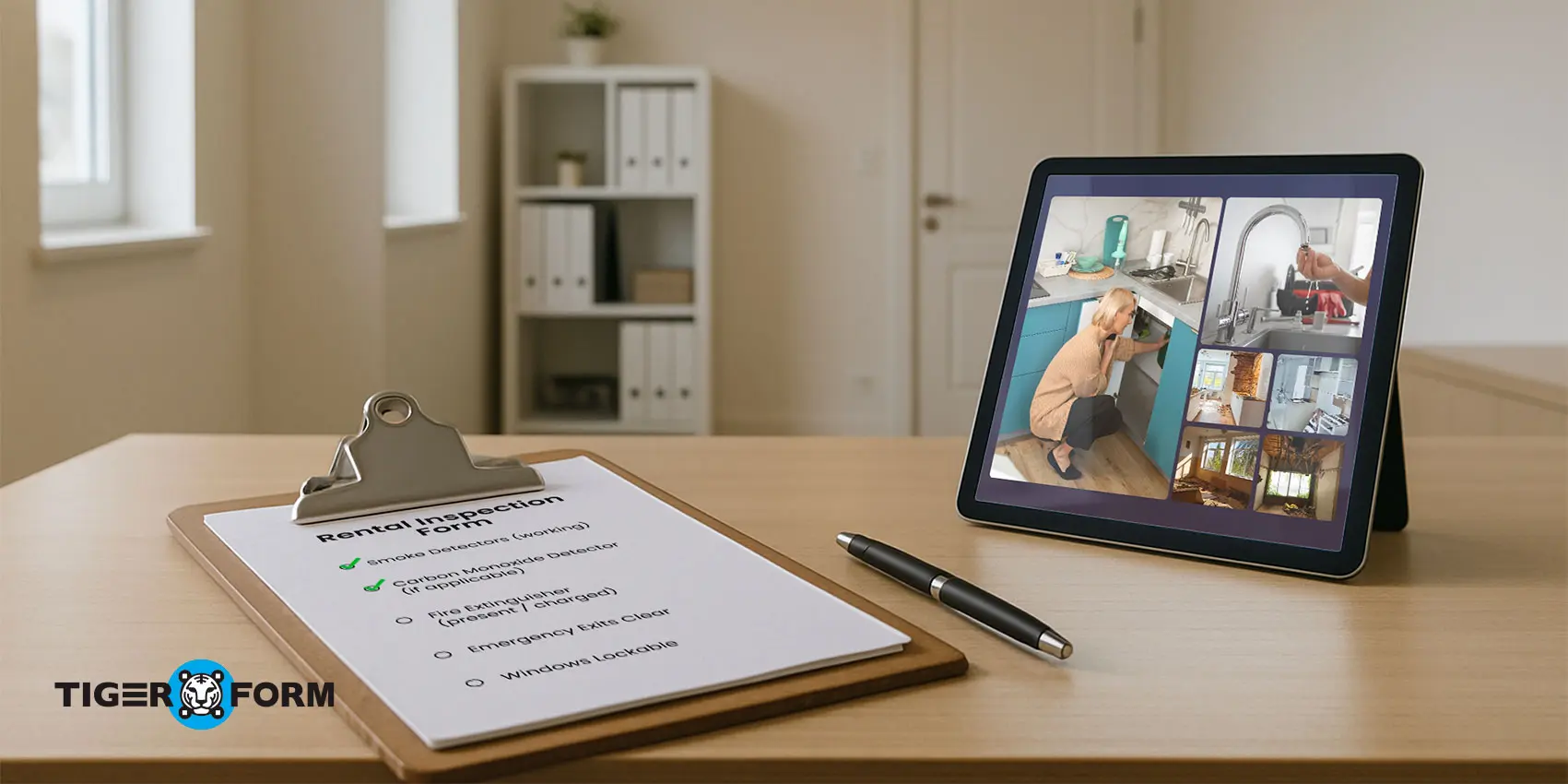
A rental property inspection form is only effective if it’s detailed, accurate, and well-structured. Whether you’re documenting a unit’s condition at move-in, move-out, or during routine checks, a consistent format ensures that nothing important is overlooked. It also helps create a clear record that protects both the landlord’s property and the tenant’s deposit.
Below are the key components every rental inspection form should include to ensure transparency, accountability, and legal protection:
1. Property address and inspection date
Every form should clearly state the complete address of the rental unit and the exact date of the inspection. This provides a timestamp for the property’s condition and ensures documentation is tied to the correct location and moment in the rental timeline.
2. Detailed checklist (Room-by-room, appliances, systems)
A room-by-room checklist allows for thorough evaluation of each space, including:
- Floors, walls, ceilings, doors, and windows
- Lighting, electrical outlets, and fixtures
- Kitchen appliances (stove, refrigerator, microwave)
- Plumbing fixtures (sinks, showers, toilets)
- HVAC systems and smoke/carbon monoxide detectors
Each item should have options to mark its condition (e.g., “Good,” “Needs Repair,” “Damaged”) and allow for brief notes.
3. Notes and comments section
There should be space for either party to leave additional observations or describe damage or concerns in more detail. This is especially useful for explaining issues that don’t fit neatly into a checklist, such as odors, missing parts, or structural issues.
4. Signature area for landlord and tenant
Both parties should sign and date the form at the end of the inspection. Signatures protect both sides in case of disputes and add legal weight to the form. This confirms that they both:
- Participated in the inspection (or reviewed its findings)
- Agree on the recorded condition of the property
- Acknowledge that the documentation may be used in future deposit or maintenance discussions
5. Photo documentation and attachments (Optional but valuable)
Including photos taken during the inspection is a highly effective way to visually support the written notes. These can show wear and tear, damage, or missing items and serve as unbiased proof if questions arise later. Attachments such as receipts, repair requests, or earlier inspection records can also be included for cross-reference.

How to make an inspection form using an online form creator
Creating a rental property inspection form with a form generator is an efficient way to streamline inspections, stay organized, and maintain digital records. Modern form creators allow landlords, property managers, and tenants to access, fill, and submit forms from any device making the process faster and easier to manage. Here are some key tips to ensure your inspection form is functional, well-structured, and aligned with your property management needs:
Step 1: Choose an online form builder
Select the best form maker platform that suits your needs. Look for platforms like TIGER FORM, which provides advanced features like conditional logic, file uploads (for photos), and template support.
Step 2: Start with a form template or a blank form
Most platforms offer inspection form templates for businesses, you can customize. If you prefer, start from scratch to build a fully personalized form. Templates save time, while blank forms give you full control over the layout and structure.
Step 3: Add basic information fields
Begin your form with standard input fields for identification:
– Property address
– Inspection date
– Type of inspection (e.g., move-in, routine)
– Inspector’s name
– Tenant name (if applicable)
Step 4: Create a room-by-room checklist
Use section breaks or headers to organize your form by area:
– Living Room, Kitchen, Bedroom(s), Bathroom(s), Exterior, etc.
– Add checkboxes or dropdowns to mark conditions (e.g., Good, Needs Repair, Damaged), and include text boxes for comments.
Step 5: Add photo upload fields
Allow inspectors or tenants to upload photos for any damage or area of concern. This can serve as visual proof and documentation in case of disputes.
Step 6: Include signature fields
Some form makers allow digital signature fields, useful for official sign-off by tenants and landlords. If not, include a final confirmation checkbox and request a signed copy in person or as a follow-up.
Step 7: Set submission settings and notifications
Configure who receives the form once it is submitted by the landlord, tenant, or property manager, and whether a copy is emailed to each party. Enable auto-responses to acknowledge submission.
Step 8: Preview, test, and publish the form
Before sharing the form, preview it to check for errors or missing fields. Then, submit it for a test to see how the final form appears. Once ready, share the form link via email, embed it on a website, or generate a QR code.
Start building your rental inspection form today
Using the right rental inspection form at the right time is the key to protecting your property and rental relationship. A properly structured form helps you serve as a legal safeguard, reduces disputes over damage and deposits, and builds trust between landlords and tenants.
Digital tools like online form creators now make it easier than ever to document, store, and retrieve inspection records, giving you real-time insight and reducing the risk of disputes. Every signature, note, and photo becomes part of a secure and shareable record, providing clarity when it matters most. Regular, well-documented inspections help identify small issues before they become costly repairs, and ensure your rental stays safe, clean, and compliant.
Now is the perfect time to get started. Choose an online form builder, customize your rental property inspection forms, and streamline your process. Visit our website to get started today.
FAQs
What is the checklist of inspection?
It’s a list used to review the condition of each part of a property during an inspection. It ensures every room, fixture, and system is checked and recorded.
What are rental inspection property checklists?
These are forms used to document the state of a rental property at different stages of a tenancy. They help landlords and tenants track damage, cleanliness, and maintenance needs.
What’s the most important form for new tenancies?
The move-in inspection form is the most essential. It records the property’s condition at the start of a lease, helping avoid disputes over deposits later.
Are landlords required to use formal rental property inspection forms?
In some regions, yes, especially where rental laws require written condition reports. Even if not mandatory, using formal forms offers legal protection and clarity for both parties.
